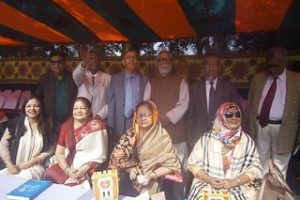The timing was hardly coincidental when North Korea’s foreign minister declared Friday that hopes for finding peace with South Korea and its protector, the United States, “faded away into a dark nightmare,” and that talking with President Donald Trump had given way to focusing on a more “reliable force to cope with the long-term military threats from the US”
It was exactly two years ago that Trump and Kim Jong Un met in Singapore, the first US president to meet face-to-face with a North Korean leader in nearly 70 years of war, uneasy armistice and nuclear standoff. At a news conference that day, Trump insisted he was the first president ever to negotiate true disarmament, which he predicted would begin imminently.
That bold initiative, once considered Trump’s signature foreign policy move, is barely mentioned in a White House overwhelmed with other crises. Two years after he enthusiastically declared on Twitter that “there is no longer a Nuclear Threat from North Korea,” classified assessments and experts outside government conclude that the country’s arsenal is far larger than it was when the leaders held the historic meeting, the first of three. The estimates vary, but most conclude the North has amassed enough fuel for about 20 nuclear weapons in the time since the two men strolled through a garden in Singapore for the ultimate post-Cold War photo opportunity.
“I think he’s going to do these things,” the president told reporters that day. “I mean, I may stand before you in six months and say, ‘Hey, I was wrong.’ I don’t know that I’ll ever admit that, but I’ll find some kind of an excuse.”
How it went wrong is a case study in the risks of overrelying on leader-to-leader diplomacy, especially with a president who dove into one of the world’s knottiest problems with little preparation. For a while, Trump answered every question about the slowness of progress the same way: that he still enjoyed a “great relationship” with Kim, and that the US would have been at war with the North by now had he not intervened.
Maybe so. But the two countries have dug in deeper than ever, with the US episodically tightening sanctions as North Korea opened new channels with China and Russia to evade them. At the same time, the North never slowed enriching uranium or working on its fleet of intercontinental ballistic missiles.
What they have avoided are any launches of missiles that could reach the US, or new nuclear tests. Both countries are struggling, in very different ways, with the coronavirus and the economic damage. And now, neither seems willing to risk an outright confrontation.
In his New Year’s speech in January 2019, Kim threatened to find a “new way” if Washington persisted with sanctions. When Kim and Trump met in Hanoi, Vietnam, the next month, their talks collapsed over differences over when to ease sanctions, and the North’s insistence that in return it would dismantle only its aging nuclear site at Yongbyon. That would have left him with other major nuclear sites, and all his missile launching capability.
Since then, North Korea has shifted gears, expressing anger and frustration with Washington and Seoul, South Korea. President Moon Jae-in of South Korea made his own visit to the North, encouraged by both Kim and Trump, telling them that they were a once-in-a-lifetime pair to negotiate a history-making deal.
“Kim Jong Un’s expectations for his meetings with Trump were big,” said Lee Byong-chul, a North Korea expert at Kyungnam University’s Institute for Far Eastern Studies in Seoul. “So was his frustration when the talks collapsed.”
In May 2019, North Korea broke an 18-month hiatus in weapons tests, launching a series of mostly short-range ballistic missiles and rockets. Negotiators from both countries met in Stockholm in October but parted ways only confirming their differences. Later, North Korea said it was no longer interested in “sickening negotiations” with the US In December, it conducted two ground tests at its missile-engine test site to bolster what it called its “nuclear deterrent.”
On New Year’s Day this year, Kim changed tactics, telling his people not to expect any immediate easing of sanctions and to brace for a prolonged struggle against the US by building a “self-reliant” economy. He warned that the world would witness a “new strategic weapon” and “a shocking actual action.”
So far that is bluster. There have been no new nuclear and intercontinental ballistic missile tests, no new ballistic missile submarine and no powerful submarine-launched ballistic missile known as Pukguksong-3.
Kim also left room for negotiations. “The scope and depth of bolstering our deterrent will be properly coordinated depending on the US future attitude,” he said.
Analysts say that while the North has a history of ramping up tensions in US election years, it knows its limits. Lee said a test of a long-range missile that could hit the US was less likely than military provocations along its disputed western sea border with South Korea.
Kim has actually gained more than he has lost through his two-year diplomacy with Trump, said Cheon Seong-whun, a former head of the Korea Institute for National Unification, a government-funded research think tank in Seoul.
“His summit meetings with President Trump elevated Kim Jong Un’s global status, while buying him time to continue to advance his nuclear weapons capabilities,” Cheon said.
Without question, Kim is more desperate for Chinese help in recent months. The North’s economy, already crippled by sanctions, is expected to shrink sharply this year because of the coronavirus — by as much as 6% by one estimate.
But Trump may also be hesitant to risk a confrontation at a moment when he faces so many challenges at home. With Americans trying to avoid the virus, combating unemployment and demonstrating for racial justice, they are unlikely to be roused by a growing North Korean nuclear arsenal.
That could leave Trump, who promised before he took office that he would “solve” the North Korea problem, in exactly the same place his last four predecessors: facing a North Korean nuclear arsenal that may be too entrenched to dismantle.






















